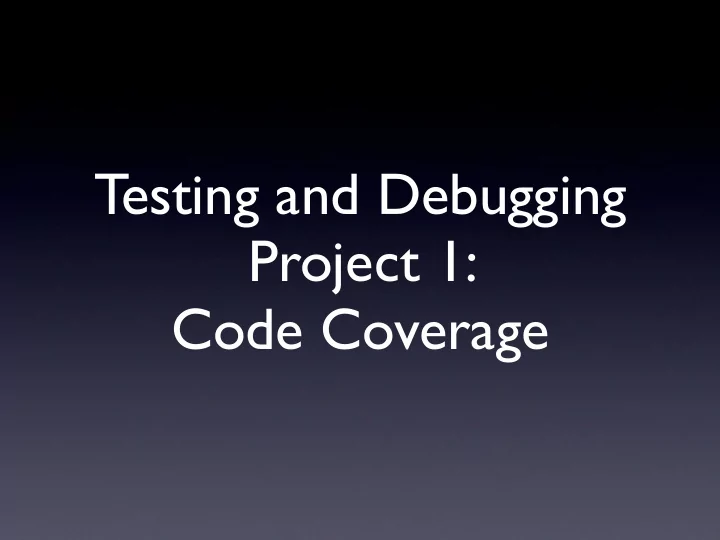

Testing and Debugging Project 1: Code Coverage
Projects http://www.st.cs.uni-saarland.de/edu/testingdebugging10/
Public Project • If you are not yet registered, you should register and meanwhile you can use the project: • User name: 1234567 • Password: tad10
Forum
Forum • Questions can be asked on the forum: https://forum.st.cs.uni-sb.de/boards/index • Password and user name outside the university: prog2-2010 • Your personal user name and password is the same as for the project.
Task (a) Write a tool that measures statement coverage. (b) Create tests that satisfy a coverage goal. (c) Implement the Tarantula fault localization technique.
Set up the project • Check out the project from the given URL • Use Maven to build it: • mvn compile • mvn assembly:assembly • mvn eclipse:eclipse
(a) Statement coverage • We recommend Eclipse AST (Abstract Syntax Tree) to instrument the source code. • AST uses visitor pattern - visit and endVisit methods. • Instrumentation should log the covered statements and write the data to disk. • See lecture: Advanced Coverage Criteria
Running Tests • ant check-coverage runs integration tests. • Produces 2 summary files: check-coverage- passing.txt and check-coverage-failing.txt.
(b) Coverage Goal • 100% Coverage has to be reached for two classes in commons-math. • JUnit 4 Templates in the project have to be completed. • Tests from the commons-math project are allowed.
(c) Fault Localization
(c) Fault Localization • Implement the Tarantula technique. (presented in the next lecture) • Paper can be obtained from our web site. (Password and user name: tad10) • ant check-fault-localization runs an integration test.
Grading • Version in svn, of 13th May will be graded. • Public tests have to be passed. • Secret tests are used for grading.
Grading for lecture
Grading Scheme for Project 1 Grade Requirement 4 at least 90% of public and 50 % of secret tests 3 100% of public and at least 50 % of secret tests 2 100% of public and at least 90 % of secret tests 1 100% of public and 100 % of secret tests
• Use svn status. • Do a fresh checkout and check whether project compiles and passes tests.
Specification is incomplete • We try to test only for specified behavior. • Tests will be made publicly available. • You can write tests that are run against the reference implementations.
Example • We only expect the start 1. for(int i = 0; (line 1) to be coverable. 2. i < 2; • See Test: 3. i++;) { AnotherLoopCoverageTest
Constructors • this and super constructor 1. public Foo() calls are not expected to be 2. super(); covered 3. this.val = 1; • “The first statement of a constructor body may be an explicit invocation of another Only line 3 is constructor of the same class expected to be or of the direct superclass coverable. (§8.8.7.1).”
Miscellaneous • You are allowed to use 3rd party libraries. • If you want to use a library not listed in pom.xml, contact us. • pom.xml and build.xml and src/test will be overwritten for secret tests.
Recommend
More recommend